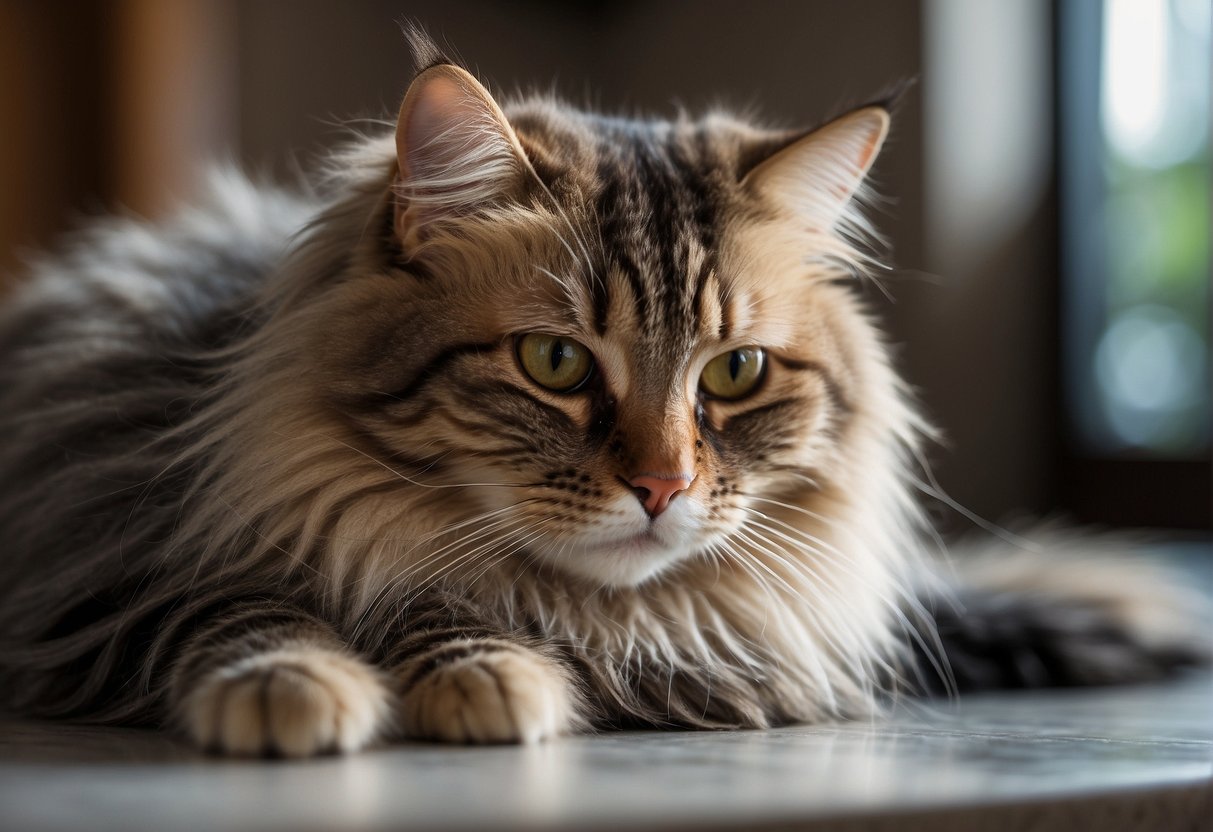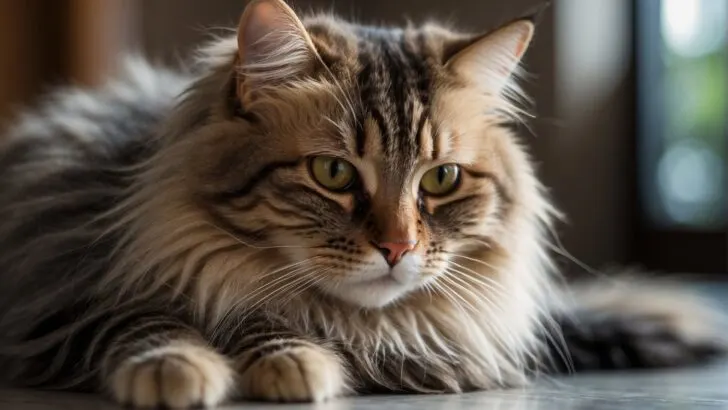Removing matted fur from your cat’s coat is a delicate process that can greatly enhance their comfort and health. Mats are dense knots of fur that can pull on the skin and trap dirt, oils, and even parasites, making them quite uncomfortable for your feline friend.
I’ve learned that addressing mats early on can prevent them from becoming painful and more difficult to manage.

You’ve probably noticed your cat grooming themselves frequently, which is their natural way of keeping their coat clean and free of mats.
However, sometimes they need a little extra help from us, especially if they have long fur, are elderly or have mobility issues that prevent thorough self-grooming. I’ve found that regular, gentle brushing helps to prevent mats from forming and maintains a healthy, shiny coat.
When mats do appear, they require careful attention to remove. Your approach should always be gentle, to avoid causing any distress or pain to your cat. In my experience, working slowly with a detangling comb or a specialized dematting tool can be effective. For particularly stubborn mats, it might even be necessary to trim them out, but this should be done with great care to avoid nicking your cat’s skin.
In some cases, seeking professional grooming services may be the safest option, ensuring the removal of mats with minimal stress for your cat.
Detailing Cat Fur and Mats
Caring for your cat involves more than just the occasional pet and feed; it’s about understanding the intricacies of their fur to keep them comfortable and healthy.
Identifying Different Types of Mats
Mats can form in your cat’s fur subtly and sometimes without immediate notice. They typically appear as clumps of tangled fur and can range from minor knots to dense, tight mats.
Short-haired cats often experience less matting than their long-haired counterparts; however, both can suffer from mats if not properly groomed. For example, a Persian’s luxurious coat is especially prone to dense matting, while a domestic shorthair might get small knots after a feisty romp outside.
The Role of Grooming in a Cat’s Life
Regular grooming is paramount in maintaining good fur health and preventing mats from forming. Cats inherently groom themselves, but regular brushing by you can significantly help manage their coat.
Brushing not only removes loose fur and dirt but also spreads natural oils throughout their coat, which promotes shine and health. A grooming routine can be a bonding experience and is often enjoyable for the cat if done gently and with care.
Influences of Breed, Diet, and Age on Cat Fur
The quality of a cat’s fur and their propensity for mats can be influenced by breed, diet, and age. Certain breeds, like Maine Coons, have a thick undercoat that requires more frequent grooming. A proper diet rich in omega fatty acids can contribute to a sleeker and healthier coat that’s less likely to matt.
As cats grow older, they may not groom as effectively, which makes your role in maintaining their coat even more significant. Regular attention to their grooming needs can keep their fur smooth and mat-free regardless of age.
Tools and Techniques for Removing Mats
Dealing with matted fur can be challenging, but with the right tools and techniques, you can minimize discomfort for your cat and ensure a smooth, mat-free coat.
Selecting the Right Brush or Comb
Your first line of defense against mats is the right brush or comb. For routine maintenance and smaller tangles:
- Wide-toothed comb: Great for gently teasing out knots.
- De-matting comb: Features specialized teeth to safely cut through mats.
- Razor comb: Useful for thinning and cutting mats close to the skin but requires a careful touch to avoid cutting the cat.
Safe Use of Scissors and Clippers
Sometimes, a brush or comb alone won’t do the job. If mats persist:
- Scissors: Choose blunt-ended scissors to prevent accidental nicks. Insert a comb between the mat and the skin to avoid cutting the skin as you trim.
- Clippers: A good option for heavier mats. Keep the clipper blade flat against the skin and gently work underneath the mat.
Always prioritize your cat’s safety, opting for gradual trimming over a quick cut.
Detangling Sprays and Home Remedies
Sprays and household items can aid in detangling:
- Detangling sprays: A quick spritz can help loosen mats prior to brushing.
- Cornstarch or talcum powder: Lightly dust onto the mat to reduce friction.
- Olive oil: In a pinch, a small amount can soften the fur, but use sparingly to avoid a greasy coat.
Preventative Measures for Matting
Maintaining your cat’s fur doesn’t have to be a struggle.
Establishing a Regular Brushing Routine
The cornerstone of preventing matted fur in cats is a regular brushing routine. Initiating this habit early, especially for long-haired breeds, is essential. Brushing several times a week can help remove loose fur and prevent dead hair from forming mats.
For those moments when your cat is less than thrilled about grooming, having a brush with soft, rounded tips makes the experience more comfortable for them.
The Importance of Diet and Supplements
A balanced diet rich in nutrients is vital for a sleek and glossy coat. Specifically, omega-3 fatty acid supplements can promote healthy skin and fur, reducing the chance of matting.
Professional Grooming and Advice
Sometimes, the best prevention strategy includes professional help. If you’re unsure about tackling your cat’s fur or you’ve encountered a particular tough mat, a professional groomer is your go-to resource. These experts can not only deal with existing mats but also provide invaluable advice on how to prevent them in the future.
Plus, they can suggest grooming tools and products that suit your cat’s specific coat type.

My name is James, and welcome to FAQCats!
Along with our team of cat owners, expert pet enthusiasts, and pet professionals, we aim to write engaging helpful, engaging content about cats. At FAQCats we strive to provide content that’s accurate and fun to read. Our team writes about everything related to cats; even the most complex of topics. Through extensive research and caring for our own fur-pals, we’re able to provide something cat owners worldwide will love. Have a look around, and leave us feedback anytime!

